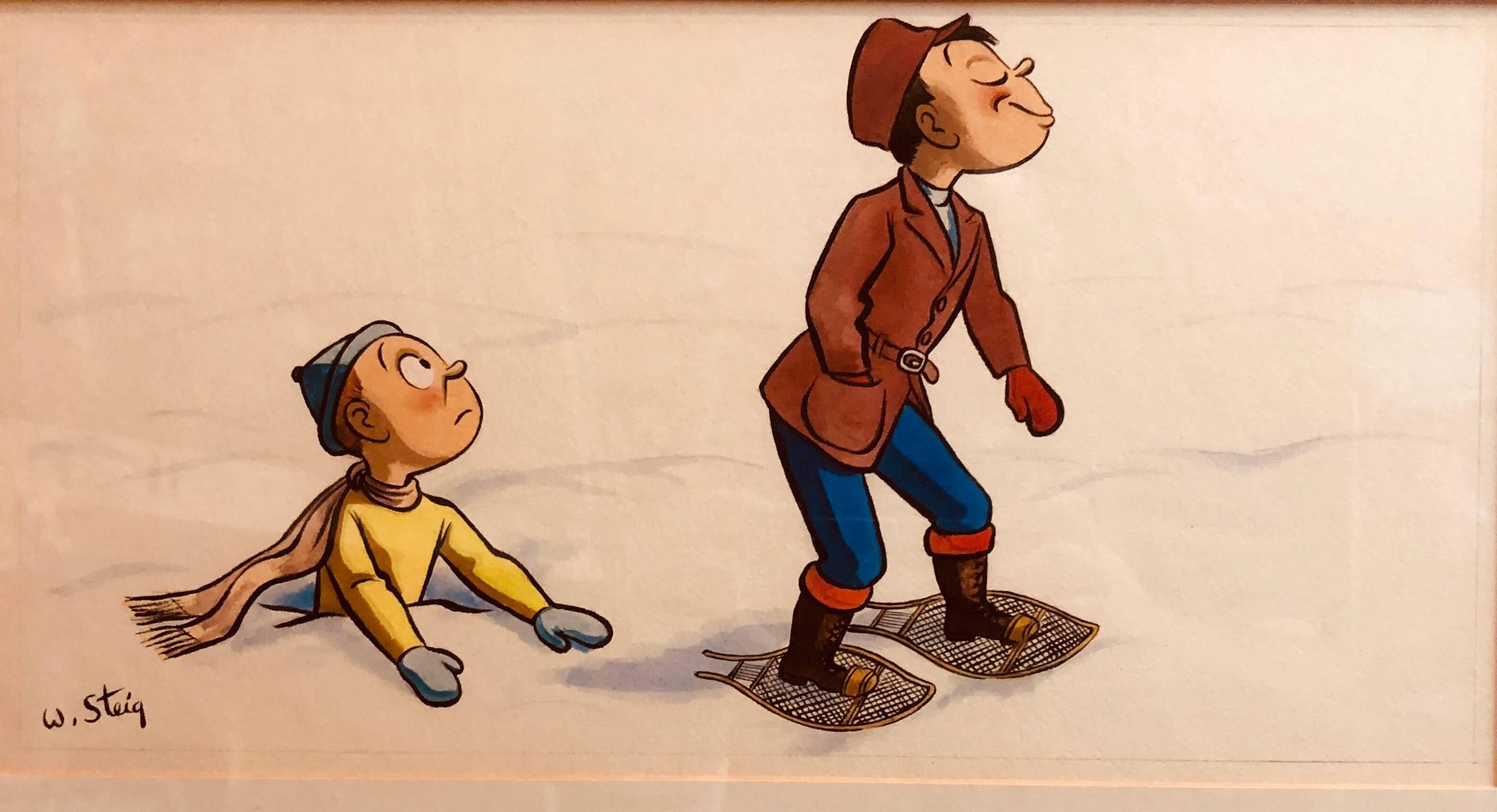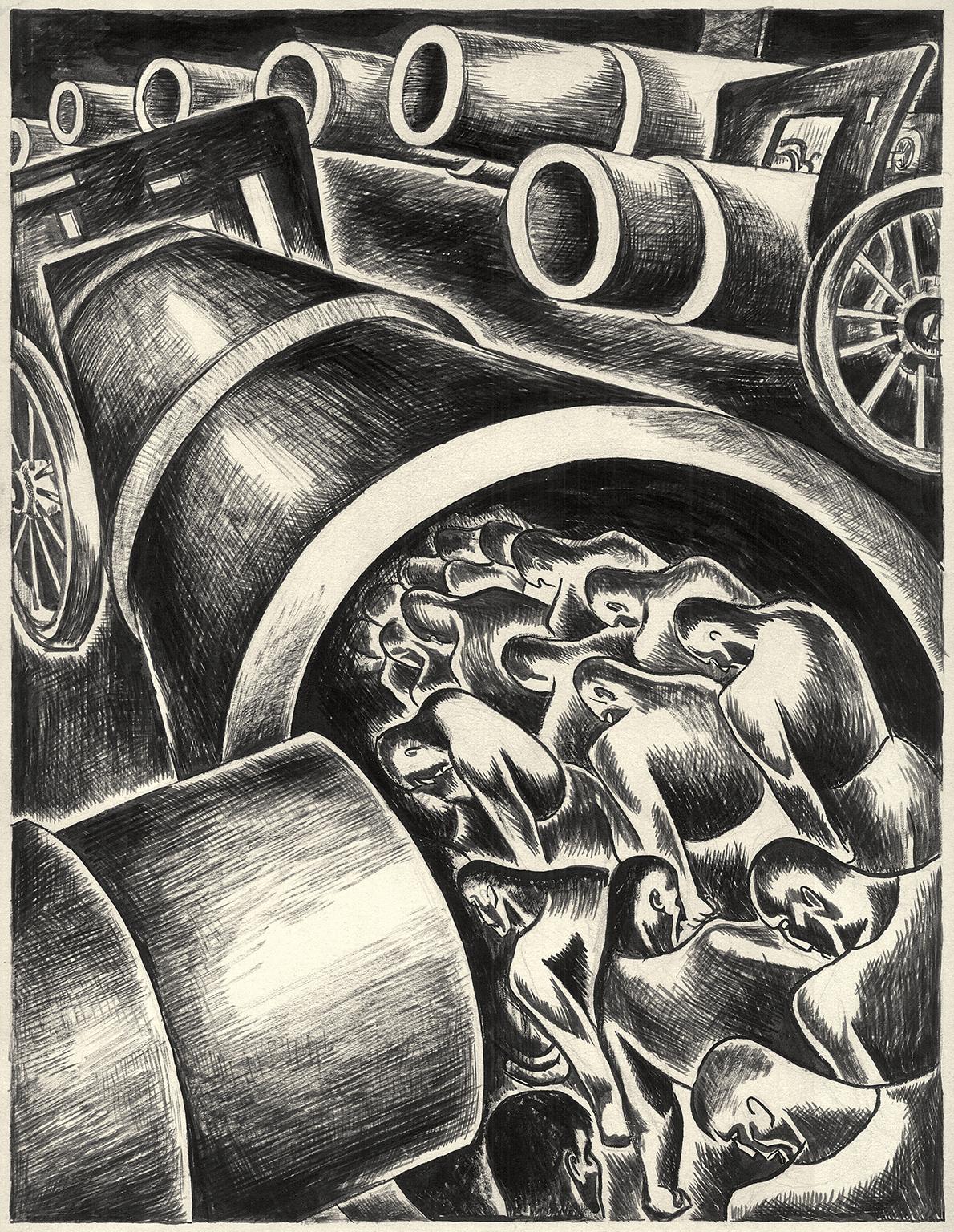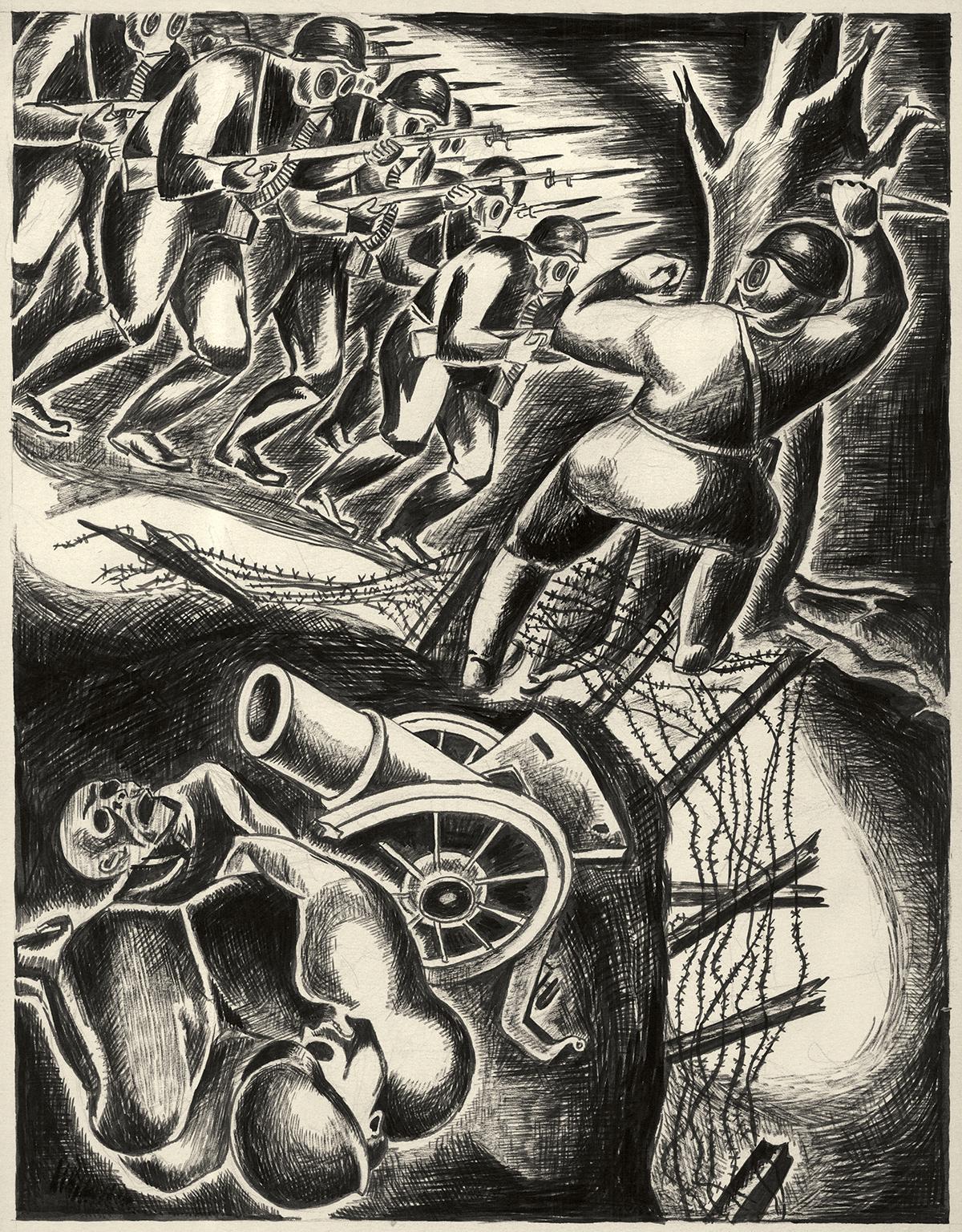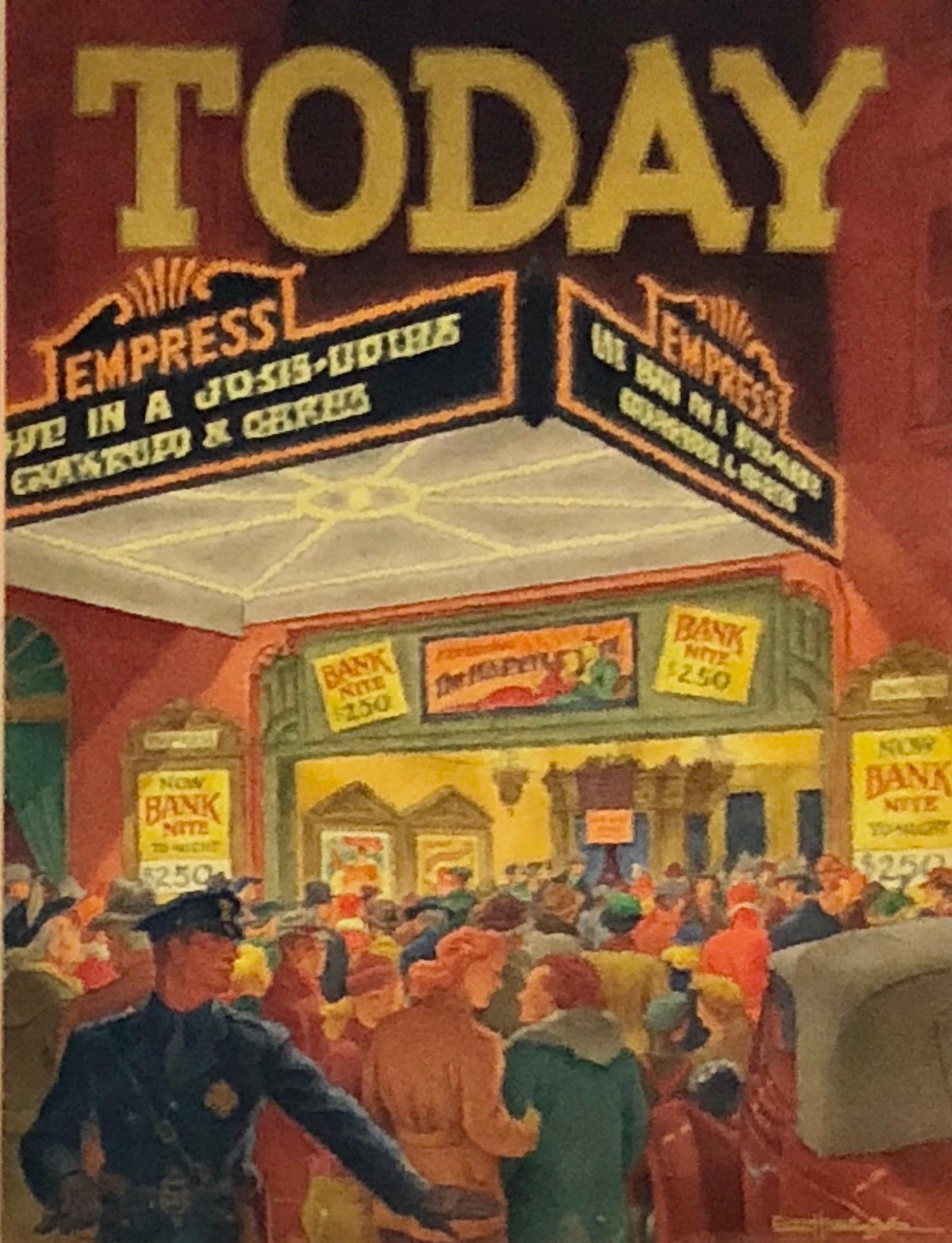Abraham WalkowitzLower East Side Crowdc. 1910
c. 1910
About the Item
- Creator:Abraham Walkowitz (1878 - 1965, American)
- Creation Year:c. 1910
- Dimensions:Height: 13.25 in (33.66 cm)Width: 10.5 in (26.67 cm)
- Medium:
- Movement & Style:
- Period:
- Condition:
- Gallery Location:Fairlawn, OH
- Reference Number:
Abraham Walkowitz
Abraham Walkowitz is perhaps best known for his watercolor studies of Isadora Duncan and the dance. However, Walkowitz laid claim to being the first to exhibit truly modernist paintings in the United States. After 1909, he became an intimate of Alfred Stieglitz's 291 Gallery, and while there became a participant in the debate over modern art in America. Walkowitz was an outspoken proponent of the continuous experimentation in the arts, which was his definition of modernism. As an artist, Walkowitz embodied the changing role of the modernist painter in the United States, as modernism moved from an avant-garde protest against established modes to become an accepted style and tradition.
Abraham Walkowitz was a Russian born, turn-of-the-century immigrant to the United States, who grew up in New York's Lower East Side. He first studied art at the Educational Alliance, the Cooper Union and the National Academy of Design. In 1906, he journeyed to Europe where he studied at the Académie Julian in Paris. Upon his return to the United States in 1907, he became a fully-fledged convert to modernism, and his first exhibit, at the Haas Gallery in that year, brought him a measure of notoriety as well as the attention of Stieglitz and other pioneers of non-objective art. In subsequent years, he became one of the most exhibited painters shown at the 291 Gallery, a fact which was also reflected in the pages of Stieglitz's polemical journal of modernism, camera work. As a result of this early attention, by the time of the Armory Show of 1913, to which Walkowitz contributed several paintings, his work was widely known to both fellow modernists as well as their opponents.
Walkowitz was clearly part of the new vocabulary of American art and criticism. During the 1920s and 1930s, as the first-generation modernists lost their revolutionary cast, and as American realism gained in favor, Walkowitz continued his experiments with form and line, especially in his series of Duncan studies. Although his paintings received less critical attention than they once had, Walkowitz was clearly one of the grand old folk of American modernism. During the depression, Walkowitz was politically active on behalf of unemployed artists supporting various new-deal initiatives in the arts. In the 1940s, Walkowitz gained national attention when he explored the varieties of the modernist vision in the form of an exhibit of 100 portraits of him by 100 artists. The result was widely discussed and was featured in Life magazine in 1944.
In 1945, Walkowitz traveled to Kansas, where he painted landscapes made up largely of strip mines and barns. This was his last venture in active painting — by 1946, glaucoma, which led to his eventual blindness, began to impair his vision and limit his ability to work. Walkowitz then turned to the preparation of a series of volumes of his drawings, designed to illustrate the development of modernism in the 20th century, and in so doing, established his role as a pioneer American modernist.
- ShippingRetrieving quote...Ships From: Fairlawn, OH
- Return PolicyA return for this item may be initiated within 10 days of delivery.
- New Orleans Sportin HouseBy Stephen LongstreetLocated in Fairlawn, OHNew Orleans Sportin House Pen and ink on paper, 1951 Signed in ink, titled and dated in pencil (see photos) Condition: Corners are pasted to support sheet, some staining in image. Image/sheet size: 15 5/8 x 18 inches Provenance: Acquired from the artist Joseph M. Erdelac, Cleveland, patron and friend of the artist Stephen Longstreet (1907-2002) The artist’s own grandchildren attempt to fathom the real life and nature of Stephen Longstreet, prolific author, artist, screenplay writer, and jazz aficionado. Born Chauncy Weiner (sometimes spelled Wiener) in New York City in 1907, Longstreet reinvented himself on a regular basis. Changing his name first to “Henry,” then “Henri,” he started his career as a commercial artist for a department store. In various public biographies he claimed to have studied in New York, London, and Paris, and said he was a student of cartoonist Ralph Barton...Category
1950s American Modern Figurative Drawings and Watercolors
MaterialsInk
- Provincetown (Sunbathing)By Peter GrippeLocated in Fairlawn, OHProvincetown (Sunbathing) Sepia ink on tan paper, 1966 Signed in ink lower center (see photo) Exhibited: Art from Lexington Homes, Lincoln Massachusetts...Category
1960s American Modern Figurative Drawings and Watercolors
MaterialsInk
- Bull Ring Brass - Mexico CityBy Stephen LongstreetLocated in Fairlawn, OHBull Ring Brass - Mexico City Watercolor, pen and ink on paper, 1955 Signed in ink, dated and titled in pencil (see photos) Condition: 1'' repaired tear left edge, along with other minor tears. Tape stains from previous matting visible in the four corners Image/Sheet size: 19 3/8 x 15 5/8 inches Provenance: Acquired directly from the Artist Joseph M. Erdelac, Cleveland, friend and patron of Longstreet Stephen Longstreet (1907-2002) The artist’s own grandchildren attempt to fathom the real life and nature of Stephen Longstreet, prolific author, artist, screenplay writer, and jazz aficionado. Born Chauncy Weiner (sometimes spelled Wiener) in New York City in 1907, Longstreet reinvented himself on a regular basis. Changing his name first to “Henry,” then “Henri,” he started his career as a commercial artist for a department store. In various public biographies he claimed to have studied in New York, London, and Paris, and said he was a student of cartoonist Ralph Barton (1891-1931). Facts that can be documented are that he was art editor for Golfer and Sportsman magazines, and was a contributor to various other magazines including The New Yorker, Saturday Evening Post, Colliers, Life, and Hooey, among others. He wrote sketches for NBC radio and the Rudy Vallee Show. In the 1930s, Longstreet worked and wrote under the names Thomas Burton, David Ormsbee, and Paul Haggard...Category
1950s American Modern Figurative Drawings and Watercolors
MaterialsIndia Ink, Watercolor, Pen
- Hells Angel on his HogBy Stephen LongstreetLocated in Fairlawn, OHHells Angel on his Hog Pen and ink on paper, 1969 Signed 'Longstreet' lower right (see photo) Titled and dated upper right Condition: excellent Image/Sheet size: 11 x 8 1/2 inches Pr...Category
1960s American Modern Figurative Drawings and Watercolors
MaterialsInk
- Lonly (Lonely)By Stephen LongstreetLocated in Fairlawn, OHSigned lower right Provenance: Joseph M. Erdelac, Cleveland, OH Possibly deaccessed from the Columbus Museum of Art THOMAS FRENCH FINE ART, LLC Stephen Longstreet (1907-2002) A...Category
20th Century American Modern Figurative Drawings and Watercolors
MaterialsWatercolor
- Girl in ProfileBy William SommerLocated in Fairlawn, OHGirl in Profile Lithographic crayon and watercolor on thin wove paper, c. 1930 Signed twice in pencil (see photos) Provenance: Estate of the Artist Edward Somme...Category
1930s American Modern Figurative Drawings and Watercolors
MaterialsWatercolor
- Whimsical Fishing Illustration Cartoon 1938 Mt Tremblant Ski Lodge William SteigBy William Steig (b.1907)Located in Surfside, FLLighthearted Illustration of Outdoor Pursuits This one of a fisherman signed "W. Steig" Provenance: from Mrs. Joseph B. Ryan, Commissioned by Joe Ryan for the bar at his ski resort, Mount Tremblant Lodge, in 1938. Mont Tremblant, P.Q., Canada Watercolor and ink on illustration board, sights sizes 8 1/2 x 16 1/2 in., framed. In 1938 Joe Ryan, described as a millionaire from Philadelphia, bushwhacked his way to the summit of Mont Tremblant and was inspired to create a world class ski resort at the site. In 1939 he opened the Mont Tremblant Lodge, which remains part of the Pedestrian Village today. This original illustration is on Whatman Illustration board. the board measures 14 X 22 inches. label from McClees Galleries, Philadelphia, on the frame backing paper. William Steig, 1907 – 2003 was an American cartoonist, sculptor, and, in his later life, an illustrator and writer of children's books. Best known for the picture books Sylvester and the Magic Pebble, Abel's Island, and Doctor De Soto, he was also the creator of Shrek!, which inspired the film series of the same name. He was the U.S. nominee for both of the biennial, international Hans Christian Andersen Awards, as a children's book illustrator in 1982 and a writer in 1988. Steig was born in Brooklyn, New York in 1907, and grew up in the Bronx. His parents were Polish-Jewish immigrants from Austria, both socialists. His father, Joseph Steig, was a house painter, and his mother, Laura Ebel Steig, was a seamstress who encouraged his artistic leanings. As a child, he dabbled in painting and was an avid reader of literature. Among other works, he was said to have been especially fascinated by Pinocchio.He graduated from Townsend Harris High School at 15 but never completed college, though he attended three, spending two years at City College of New York, three years at the National Academy of Design and a mere five days at the Yale School of Fine Arts before dropping out of each. Hailed as the "King of Cartoons" Steig began drawing illustrations and cartoons for The New Yorker in 1930, producing more than 2,600 drawings and 117 covers for the magazine. Steig, later, when he was 61, began writing children's books. In 1968, he wrote his first children's book. He excelled here as well, and his third book, Sylvester and the Magic Pebble (1969), won the Caldecott Medal. He went on to write more than 30 children's books, including the Doctor DeSoto series, and he continued to write into his nineties. Among his other well-known works, the picture book Shrek! (1990) formed the basis for the DreamWorks Animation film Shrek (2001). After the release of Shrek 2 in 2004, Steig became the first sole-creator of an animated movie franchise that went on to generate over $1 billion from theatrical and ancillary markets after only one sequel. Along with Maurice Sendak, Saul Steinberg, Ludwig Bemelmans and Laurent de Brunhofff his is one of those rare cartoonist whose works form part of our collective cultural heritage. In 1984, Steig's film adaptation of Doctor DeSoto directed by Michael Sporn was nominated for the Academy Award for Best Animated Short Film. As one of the most admired cartoonists of all time, Steig spent seven decades drawing for the New Yorker magazine. He touched generations of readers with his tongue–in–cheek pen–and–ink drawings, which often expressed states of mind like shame, embarrassment or anger. Later in life, Steig turned to children's books, working as both a writer and illustrator. Steig's children's books were also wildly popular because of the crazy, complicated language he used—words like lunatic, palsied, sequestration, and cleave. Kids love the sound of those words even if they do not quite understand the meaning. Steig's descriptions were also clever. He once described a beached whale as "breaded with sand." Throughout the course of his career, Steig compiled his cartoons and drawings into books. Some of them were published first in the New Yorker. Others were deemed too dark to be printed there. Most of these collections centered on the cold, dark psychoanalytical truth about relationships. They featured husbands and wives fighting and parents snapping at their kids. His first adult book, Man About Town, was published in 1932, followed by About People, published in 1939, which focused on social outsiders. Sick of Each Other, published in 2000, included a drawing depicting a wife holding her husband at gunpoint, saying, "Say you adore me." According to the Los Angeles Times, fellow New Yorker artist...Category
1930s American Modern Figurative Drawings and Watercolors
MaterialsIndia Ink, Watercolor, Illustration Board
- Whimsical Illustration "Snow" Cartoon, 1938 Mt Tremblant Ski Lodge William SteigBy William Steig (b.1907)Located in Surfside, FLLighthearted Illustration of Outdoor Pursuits This one being cross country Snow Shoes signed "W. Steig" Provenance: from Mrs. Joseph B. Ryan, Commissioned by ...Category
1930s American Modern Figurative Drawings and Watercolors
MaterialsIndia Ink, Watercolor, Illustration Board
- War Machine — Spanish Civil War, Anti-fascismBy Leon BibelLocated in Myrtle Beach, SCLeon Bibel, 'Untitled (War Machine)', brush and ink, c. 1936. Estate stamped, verso. A fine expressionist rendering, on cream wove drawing board, with marg...Category
1930s American Modern Figurative Drawings and Watercolors
MaterialsInk
- Death March — Spanish Civil War, Anti-fascismBy Leon BibelLocated in Myrtle Beach, SCLeon Bibel, 'Untitled (Death March)', brush and ink, c. 1936. Estate stamped, verso. A fine expressionist rendering, on cream wove drawing board, with margins (3/8 to 5/16 inch). Minor toning at the board edges, otherwise in very good condition. Image size 12 5/16 x 9 3/8 inches; sheet size 13 x 10 inches. Matted to museum standards, unframed. One of a series of powerful Anti-fascist brush and ink drawings created by the artist at the commencement of the Spanish Civil War...Category
1930s American Modern Figurative Drawings and Watercolors
MaterialsInk
- Magazine Cover Illustration Mid 20th Century Modern Theatre Broadway Realism WPABy Ernest Hamlin BakerLocated in New York, NYMagazine Cover Illustration Mid 20th Century Modern Theatre Broadway Realism WPA Ernest Hamlin Baker (1889 – 1975) “Today Magazine” Cover ...Category
1930s American Modern Figurative Drawings and Watercolors
MaterialsGouache, Paper, Watercolor, Ink
- "Marc Chagall" Original Drawing Illustration Caricature William Saroyan bookBy Albert Al HirschfeldLocated in New York, NY"Marc Chagall" Original Drawing Illustration Caricature William Saroyan book This drawing was published in the 1976 edition of William Saroyan's SONS ...Category
1970s American Modern Figurative Drawings and Watercolors
MaterialsInk, Board






